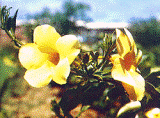
ALLAMANDA CATHARTICA L. - GOLDEN TRUMPET VINE.
Common name
Yellow allamanda, golden trumpet, yellow bell, angel's trumpet, buttercup flower, bunga akar kuning, wilkens-bita, llamarada, brownbud.
Family
Apocynaceae (Dogbane family).
Overview
Yellow allamanda, a prolific bloomer, is a scrambling, perennial shrub or vine up to 15 feet tall found on the riverbanks in Suriname; it is a fast grower.
The big yellow funnel-shaped flowers are arranged in rather long racemes; mostly at the end of the branches. The leaves are smooth, thick, opposite and pointed.
The fruits are prickly capsules, splitting to release winged seeds.
Yellow allamanda has white milky sap in all parts, which oozes out as soon as it is broken.
All parts of the plant are considered poisonous and highly cathartic.
Suriname's traditional medicine
The roots are used against jaundice, complications with malaria and enlarged spleen. The flowers act as a laxative. Yellow allamanda has also an antibiotic action against Staphylococcus.
Hardiness
Warm Humid to Hot Humid
Propagation
Seeds and cuttings
Culture
Full sun; moist, rich humus soil. Tolerant of many soil types; no salt tolerance. Can be grown as an container plant indoors in the cooler zones.
Sensitive to frost, foliage hardy to 1 ° C for a short time.
Except to their tenderness to frost, they grow without major impediment.
Landscape uses: as a shrub if pruned, as a vine on a trellis.